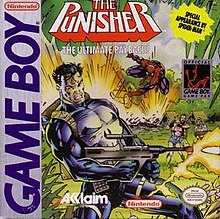The Punisher: The Ultimate Payback!
| The Punisher: The Ultimate Payback! | |
|---|---|
 Cover art | |
| Developer(s) | Beam Software |
| Publisher(s) | Acclaim Entertainment[1] |
| Designer(s) | Gregg Barnett Rod Richards |
| Programmer(s) | Rod Richards |
| Artist(s) | Tony G. Pentland Eve Marks |
| Composer(s) | Gavan Anderson Tania Smith |
| Platform(s) | Game Boy |
| Release |
|
| Genre(s) | Shoot 'em up |
| Mode(s) | Single-player |
The Punisher: The Ultimate Payback!, released in 1991 by Acclaim Entertainment,[2] is the Game Boy version of the 1990 NES game The Punisher.[1][3] It follows the Marvel Comics vigilante Frank Castle, also known as the Punisher. Updates after the NES version include cameo appearances of Spider-Man[4] and the final boss was switched from Kingpin to Jigsaw.[5]
Plot
[edit]As in the NES version, the Punisher's origin has been slightly altered from that of the comic books, so he is a former police detective instead of a US Marine.[6] The game follows Frank Castle after the death of his wife and children at the hands of the mafia, and he became a vigilante who hunts and kills every criminal he believes deserves it.[1]
The game begins with Spider-Man telling Punisher that a drug lord is hiding in a mall and that he has to get him. Frank Castle shoots villains while protecting the innocent. Spider-Man appears between the action to offer advice on how to beat upcoming levels and swings in to rescue hostages once their captors have been shot.
At the end of the game when Jigsaw realizes that The Punisher is going to kill him, Castle says, "Penance is good for the soul, but punishment is good for the guilty".[7]
Gameplay
[edit]The player controls Frank Castle (the Punisher) from an over-the-shoulder third-person perspective through various New York City locations, shooting thugs and battling enemies such as Hitman, Colonel Kliegg, Sijo Kanaka, and Assassin as bosses. The final boss is Jigsaw. Power-ups can be obtained by shooting them onscreen and include extra ammunition, a med kit, kevlar, a machine gun, a bazooka, and grenades.
Reception
[edit]Blair Farrell of Comic Gamers Assemble criticized the game for removing the player's ability to move the Punisher across the screen but understood it was due to the size of the screen. He stated that the game is relatively short and difficult, and that Spider-Man's appearances did not make sense for the character considering that he would never aid the Punisher in killing his enemies. He said the game is overall very inferior to the NES version but has the advantage of separate soundtracks for each level.[8]
Other reviewers have criticized the game for having very light player assistance and few health drops but that it is still relatively entertaining.[9] Others commented on straying from the source comics.[10]
See also
[edit]References
[edit]- ^ a b c "The Punisher [1991]". IGN. Retrieved 23 July 2015.
- ^ "The Punisher: The Ultimate Payback". GameFAQs. Retrieved 2016-09-23.
- ^ "The Punisher: The Ultimate Payback! (Game Boy)". MobyGames. Retrieved 23 July 2015.
- ^ "The Punisher: The Ultimate Payback! (Game Boy) review". MobyGames. June 7, 2008. Retrieved 23 July 2015.
- ^ Rojas, Fred (April 14, 2013). "Review: The Punisher (NES)". Gaming History 101. Retrieved 2016-08-21.
- ^ "The Punisher". GameFAQs. Retrieved 2016-08-22.
- ^ "Game Endings Guide". GameFAQs. December 18, 2014. Retrieved September 23, 2016.
- ^ Farrell, Blair (July 11, 2014). "REVIEW: THE PUNISHER: THE ULTIMATE PAYBACK! (GAME BOY)". comicgamersassemble.com. Retrieved 2016-08-21.
- ^ "The Punisher" (PDF). Games-X. No. 24. Europress. October 3, 1991. p. 34. Retrieved October 29, 2024.
- ^ "The Punisher". Gamble! (in German). No. 24. VGC VideoGamblers. November 1991. p. 50.
